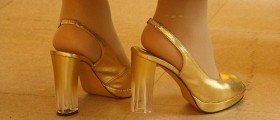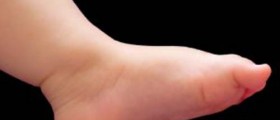
A Tailor's union is an abnormality of the bone at the base of the little toe. The foot bones called the metatarsal bones are held together by tendons and ligaments. When ligaments become more flexible they cause the bones to move, resulting in the bones protruding outward. The bone becomes deformed and enlarged so the bump is formed on the outer side of the foot. The toe is turned inward and usually becomes red and painful. Tailor's union is a common deformity in women.
Flat feet, injuries and weak ligaments lead to the forming of such bumps. If untreated, uncomfortable shoes, especially tight shoes or high heels, put pressure on the bump making it larger and causing swelling and pains.
The first step to take to avoid Tailor's union is to change shoes. When the bump has already been formed change the shoes. A person should avoid wearing shoes with pointed toe parts because such shoes press toes. It is recommendable to wear shoes with wider fronts. Wearing sandals can also be effective. To relieve the pain and soothe the inflammation, corticosteroid injections into the affected area have proven to be a good treatment. Introducing oral medications in therapy can also be effective. A doctor prescribes the type and dosage of medicine. There are also bunionette pads worn over the Tailor's union. Slight massaging and rubbing the specific oil can help reduce the pain. Placing the ice over the bump can also be effective.
The best method is, however, to reestablish the balance of the foot and enable the foot to function properly. This is accomplished by applying custom-made orthotic devices, which reduce the flexibility of the bones and protect them from too much pressure. The further swelling and enlarging of the bump is thus prevented and the pain is greatly alleviated. Wearing such devices also relieves the pains in the shins, knees and lower back which are caused by Tailor's union.
If these devices do not help or if any method fails to give results and improvement, a surgery may be needed. A Tailor's bunionectomy is performed in order to remove the protruding part of the bone and place it in line with other bones. In this correction surgery the fifth metatarsal bone is slightly fractured and cleared off the bumping part and put back into its place, tightly to its ligaments and tendons. The patient has to rest and limit walking and standing. Wearing special shoes for treatment after the surgery is necessary to achieve the best results.

















Your thoughts on this
Loading...